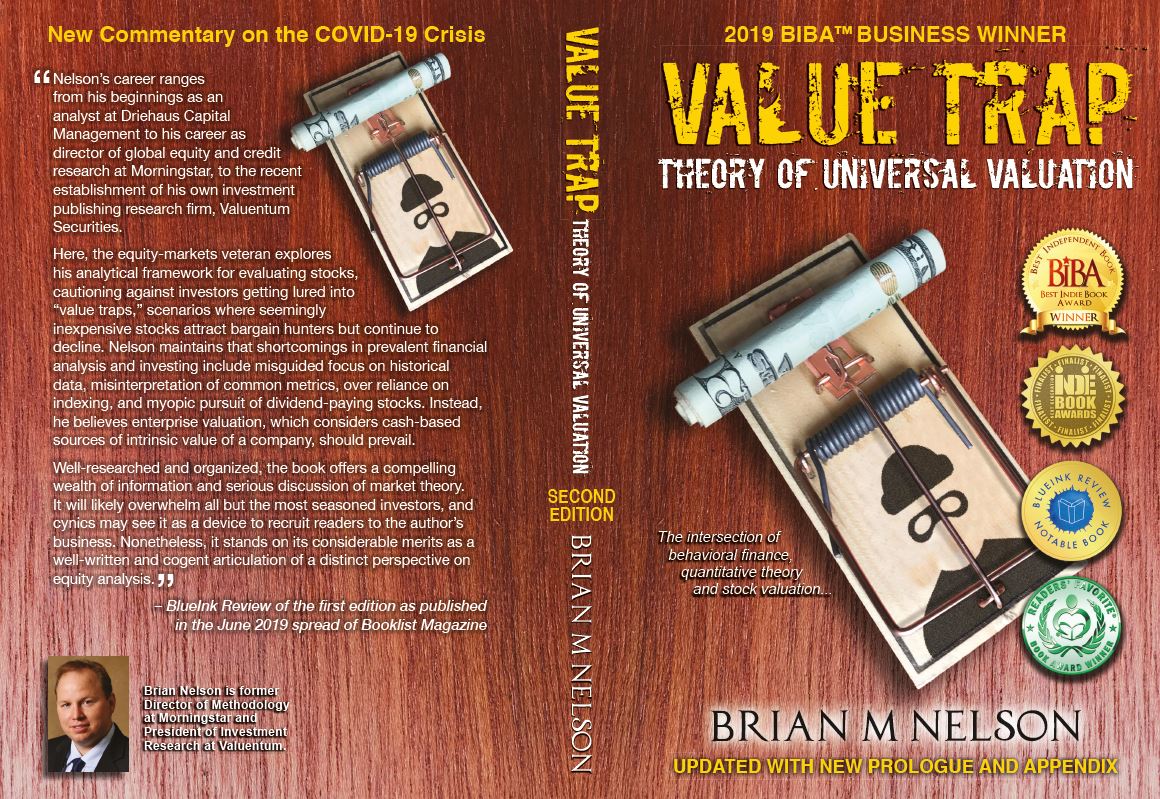Member LoginDividend CushionValue Trap |
ICYMI: As Expected, Stock Pickers Trounce the Indexes When It Matters
publication date: Feb 22, 2023
|
author/source: Brian Nelson, CFA
Image: Charles Dickens. Image Source: Public Domain “It was the best of times, it was the worst of times, it was the age of wisdom, it was the age of foolishness, it was the epoch of belief, it was the epoch of incredulity, it was the season of light, it was the season of darkness, it was the spring of hope, it was the winter of despair.” -- Charles Dickens, A Tale of Two Cities By Brian Nelson, CFA It was the best of times with respect to relative “outperformance,” it was the worst of times with respect to absolute "performance." During 2022, that is. If all that our readers were focused on last year were our missteps in Meta Platforms (META) and PayPal (PYPL), one might think that 2022 was one of Valuentum’s worst years ever. But that was far different than reality. Based on our calculations, we estimate that the hypothetical "returns" of the simulated Best Ideas Newsletter (BIN) portfolio exceeded the S&P 500 (SPY) by roughly 4.9 percentage points,* on a price-only basis, during 2022. Similarly, we estimate that the hypothetical "returns" of the simulated Dividend Growth Newsletter (DGN) portfolio exceeded the S&P Dividend ETF SPDR (SDY) by ~1.5 percentage points, on a price-only basis during 2022. We continue to provide updates with respect to the High Yield Dividend Newsletter portfolio and ESG Newsletter portfolio in those respective publications. 2022 was a bloodbath for many strategies. According to Vanguard’s website, the 60/40 stock/bond portfolio generated a return of -16.9% (negative 16.9%) during 2022, and that includes the income component. Excluding any dividends, by our estimates, after very strong years in 2019, 2020, and 2021, the simulated Best Ideas Newsletter portfolio generated a hypothetical return of -14.8% (negative 14.8%),* while the simulated Dividend Growth Newsletter portfolio generated a hypothetical return of -1.8% (negative 1.8%) during 2022. Is beating the market really that easy? After all, you saw that we fell into a few big traps with Meta Platforms and PayPal last year. If you weren’t following our newsletter portfolios closely, however, one might think the newsletter portfolios were down 25% or more on the year given our tech-heavy and large cap growth focus. But that just wasn’t the case. Overweighting energy heading into 2022 and “raising cash” during the August 2022 technical top were two of the primary reasons for the relative "outperformance" in the BIN portfolio, despite Meta's and PayPal's shortcomings. Is this “outperformance” luck or skill? Well, this may be more of a difficult question to answer. First, we made a conscious decision to “overweight” energy heading into 2022 and we made a conscious decision to “raise cash” in August 2022, and we released this information in full transparency to members. Exxon Mobil (XOM) and Chevron (CVX) were clearly Valuentum stocks, too, and we wrote as much with respect to Exxon in January of last year, “Exxon Mobil Is A Valuentum Style Stock With a Hefty Dividend Yield,” prior to its huge run. Stock pickers truly did well during 2022. According to a recent note by Bloomberg, “62% of active large-company “core” funds--those that buy a mix of growth and value stocks--beat the market (during 2022). That’s the highest percentage of active portfolios to notch a win since 2005.” As hypothesized, active fund managers tend to add the most value during downturns, and as the BIN and DGN portfolios have shown, some all-equity portfolios can even carve out relative “outperformance” compared to a “more conservative” 60/40 stock/bond portfolio. Things tend to take care of themselves during bull markets, which is why it's during a difficult bear-market period when "outperformance" matters most. Indexers have tried to “explain away” the stock picker outperformance (active holding more cash for redemptions) and the demise of the 60/40 stock/bond portfolio ("it's just one year") during 2022, but as we “experienced,” investors could have gotten a number of things wrong during 2022 and still have done better than the S&P 500 as well as asset allocators relying on a "more conservative" 60/40 stock/bond mix. From our perspective, active stock selection is as much a risk-management tool as that of traditional asset allocation, and during 2022, active stock selection showed it can even hedge sequence-of-return risk better than the "more conservative" 60/40 stock/bond portfolio, itself. With all that has been written about indexing, right or wrong, the past many decades, it's easy to dismiss 2022 as just one year where stock pickers may have gotten lucky, or the 60/40 stock/bond portfolio just had a rough year as inflation wreaked havoc on the widely-followed asset allocation strategy. But it’s more than that, in our view. Many stock pickers did fantastic during the bull market of the past decade--far better than the 60/40 stock/bond portfolio--and then these same stock pickers also outperformed during the bear market of 2022. This is no small deal. For stock pickers that captured a huge chunk of the outsized equity returns during the past decade's bull market and then also outperformed during the doldrums of 2022, it's the baseball-equivalent of hitting a grand slam to win the World Series. Here's what we wrote in the second edition of Value Trap (released July 2020), prior to one of the worst years of the 60/40 stock/bond portfolio in history:
Many were caught off-guard with the 60/40 stock/bond portfolio's weakness during 2022, but not readers of Value Trap. The breakdown in correlations between stocks and bonds was clear as day during the COVID-19 collapse, a foreshadowing of what was to come in 2022. We look forward to writing and releasing the third edition of Value Trap, where we also plan to publish updated simulated portfolio performance across our newsletter suite since inception.* Concluding Thoughts
We are big believers in prudent and diversified stock selection more than we ever have before, and we have little confidence in applying correlations, as in traditional asset allocation, to try to achieve financial goals and manage risks. In this age of wisdom, we like to follow the data, and the data keeps pointing to prudent and diversified stock selection as one of the best risk-adjusted ways to achieve long-term financial goals. To each, their own, but we continue to like stocks for the long run, and 2022 was yet another example why! * We wanted to provide additional transparency regarding the BIN portfolio's hypothetical returns through the course of 2022. On a price-only basis, as of August 19 (interim), the BIN portfolio was down 8.6% (+2.6pts relative to the SPY), down 16.7% as of October 18 (+5.4pts), down 16.4% as of November 9 (+5pts), down 14.8% as of December 30 (+4.9pts). Past performance is not indicative of future performance. Valuentum's newsletter portfolios represent simulated returns based on hypothetical calculations performed by us. ---------- It's Here!
The Second Edition of Value Trap! Order today!
 -----
Brian Nelson owns shares in SPY, SCHG, QQQ, DIA, VOT, BITO, RSP, and IWM. Valuentum owns SPY, SCHG, QQQ, VOO, and DIA. Brian Nelson's household owns shares in HON, DIS, HAS, NKE, DIA, and RSP. Some of the other securities written about in this article may be included in Valuentum's simulated newsletter portfolios. Contact Valuentum for more information about its editorial policies. Valuentum members have access to our 16-page stock reports, Valuentum Buying Index ratings, Dividend Cushion ratios, fair value estimates and ranges, dividend reports and more. Not a member? Subscribe today. The first 14 days are free. |



0 Comments Posted Leave a comment